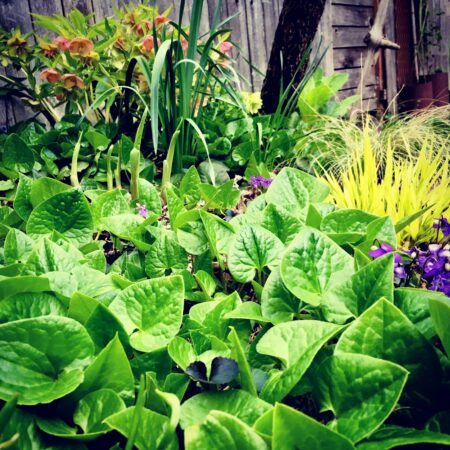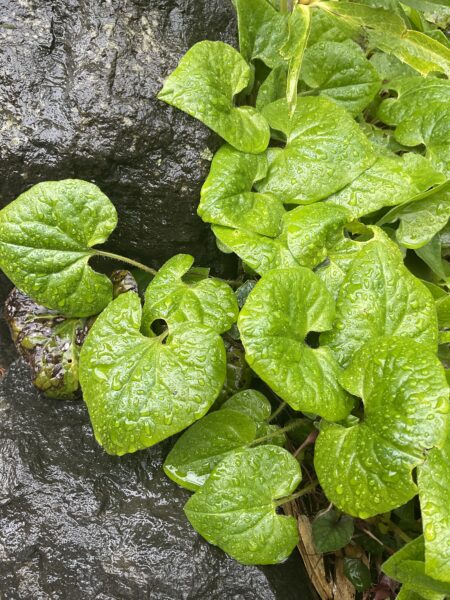Wild Ginger Love
February 8, 2024

privacy
a sheltering hood
of shining green,
shaped in the symbol of love
two lobes atop a point,
heart overlapping heart,
like boudoir sheets unmade,
the leaves cover,
they drape,
hiding and revealing
what’s bare
and what’s blossoming
below.
the name: Wild Ginger,
an erotic personality,
confirmed by musky spice
when closely rubbed,
and by
her hidden flower:
triangle-petaled,
fleshy maroon,
with three spreading tails,
centered by moist-starred
pistil.
such things are made for privacy,
and what a private moment it is
to lift one glossed leaf
revealing one perfect
wild ginger flower.

Other than wild ginger’s erotic qualities, she’s one to look at closer for her essential and highly functional role as an evergreen, shade garden ground cover. I love her style of weaving around other plants and between stones with fleshy, spreading stolons and rhizomes. Hellebores emerging freshly-flowered above a cover of wild ginger are elevated by her shine below. Winter dormant false Solomon’s seal appreciates the protection wild ginger provides from torrents of rainfall. And, fringecup’s foliage, blushed plum from the bite of frost, clumps companionably with wild ginger’s deep green sheen.
Called Asarum caudatum in botanical latin, our western native wild ginger is not to be confused with the obnoxious weed Arum italicum. That bane of many local gardeners with its arrow-shaped leaves, calla-like flowers, and spears of red berries shares a portion of its name with wild ginger, but is no relative, nor friend. By all means, avoid adding Arum to your garden even though some nurseries continue to stock it.
Alternately, the common name, wild ginger, calls to mind the tropical plant you know for it’s nubbed rhizome that you grate into your dinner or brew into a belly-warming tea. Again, they’re not at all related. And, they’re only friendly through their shared scent of earthy spice. True ginger is best grown in decidedly warmer climates than ours and purchased from your local grocer.
Our wild ginger is best sourced from native plant nurseries. Beware the retail nursery that tries to convince you to grow Chinese wild ginger (Asarum splendens) instead. Showy with patterned leaves like cyclamen, this oriental cousin is much more finicky than Western wild ginger in the garden. Slugs adore it and our months of dry summer diminish it further. I’d rather have pure green reliability, un-browsed, and drought-adapted than the novelty of speckles.
In my earliest memories of walking under Doug firs (way back when sword ferns arched upward greeting my young gaze with their ancient, faceless regard, eye-to-spore), rounded hearts of green pattern the ground, interspersed with plush moss and needled duff. In the wild forests, my old beloved Asarum caudatum leafs out intermittently—one here, one there, their outlines boldly distinct, recognizably cordate in their singularity against the smaller scale of fir needles and moss leaves.
In garden ground, however, particularly where the loam tends more toward sandy than clayey, wild ginger thrives with generous layers of leaves, the pattern becoming a jumble of Valentine’s heaped and spread around generously for all comers. Is it the shade of the mature gardener smiling down upon them that boosts their proliferation? Cultivated soil and supplemental irrigation likely influence the lushness. Either way, it’s heartening to embrace a native plant that thrives so lavishly in the garden. Not all natives do. Some prefer wildness alone, shrinking with human interference.
All this talk of leaves and I’ve yet to disclose to you the most curious and compelling component: wild ginger’s flowers. Perhaps it’s best to let you discover those on your own. Knee to ground, inhaling the petrichor of moist earth, lift the shielding leaves to unveil the surprise of ground-level blooms. Imagine yourself an ant (no, not the pesky sugar ants on your kitchen counter, but one playing their part in the garden ecosystem) encountering a blossom made just for you, with seeds awaiting your industrious dispersal. Add wild ginger to your shade garden now, and you won’t have to travel far to experience such a moment of wonder this coming spring when they unfurl their private blooms.
